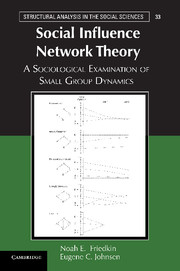Crossref Citations
This Book has been
cited by the following publications. This list is generated based on data provided by Crossref.
Friedkin, Noah E.
2011.
A Formal Theory of Reflected Appraisals in the Evolution of Power.
Administrative Science Quarterly,
Vol. 56,
Issue. 4,
p.
501.
2011.
Publications Received.
Contemporary Sociology: A Journal of Reviews,
Vol. 40,
Issue. 6,
p.
785.
Leilei, Chang
Ben, Cheng
Mengjun, Li
and
Jiang, Jiang
2012.
Multi-view and network modeling for technology system of systems.
p.
297.
Childress, C. Clayton
and
Friedkin, Noah E.
2012.
Cultural Reception and Production.
American Sociological Review,
Vol. 77,
Issue. 1,
p.
45.
Bassett, Danielle S.
Alderson, David L.
and
Carlson, Jean M.
2012.
Collective decision dynamics in the presence of external drivers.
Physical Review E,
Vol. 86,
Issue. 3,
Hoffmann, Till
Porter, Mason A.
and
Lambiotte, Renaud
2012.
Generalized master equations for non-Poisson dynamics on networks.
Physical Review E,
Vol. 86,
Issue. 4,
Gromoff, Alexander
Stavenko, Julia
and
Evina, Kristina
2012.
Modern Necessities in Educational Process Innovation.
IERI Procedia,
Vol. 2,
Issue. ,
p.
815.
Muchnik, Lev
Aral, Sinan
and
Taylor, Sean J.
2013.
Social Influence Bias: A Randomized Experiment.
Science,
Vol. 341,
Issue. 6146,
p.
647.
Hackett, Adam
and
Gleeson, James P.
2013.
Cascades on clique-based graphs.
Physical Review E,
Vol. 87,
Issue. 6,
Sathanur, Arun V.
Jandhyala, Vikram
and
Xing, Chuanjia
2013.
Capturing signatures of anomalous behavior in online social networks.
p.
327.
Gabbay, Michael
2013.
Complex Sciences.
Vol. 126,
Issue. ,
p.
95.
Mäs, Michael
Flache, Andreas
and
Perc, Matjaz
2013.
Differentiation without Distancing. Explaining Bi-Polarization of Opinions without Negative Influence.
PLoS ONE,
Vol. 8,
Issue. 11,
p.
e74516.
Sathanur, Arun V.
Jandhyala, Vikram
and
Xing, Chuanjia
2013.
PHYSENSE: Scalable sociological interaction models for influence estimation on online social networks.
p.
358.
Cozzo, Emanuele
Baños, Raquel A.
Meloni, Sandro
and
Moreno, Yamir
2013.
Contact-based social contagion in multiplex networks.
Physical Review E,
Vol. 88,
Issue. 5,
Thye, Shane
and
Kalkhoff, Will
2014.
Handbook of the Social Psychology of Inequality.
p.
27.
Helbing, Dirk
Yu, Wenjian
Opp, Karl-Dieter
Rauhut, Heiko
and
Chialvo, Dante R.
2014.
Conditions for the Emergence of Shared Norms in Populations with Incompatible Preferences.
PLoS ONE,
Vol. 9,
Issue. 8,
p.
e104207.
Contractor, Noshir S.
and
DeChurch, Leslie A.
2014.
Integrating social networks and human social motives to achieve social influence at scale.
Proceedings of the National Academy of Sciences,
Vol. 111,
Issue. supplement_4,
p.
13650.
Marmo, Roberto
2014.
Encyclopedia of Business Analytics and Optimization.
p.
2221.
Gabbay, Michael
and
Das, Arindam K.
2014.
International Conference on Theory and Application in Nonlinear Dynamics (ICAND 2012).
p.
167.
Bezemer, Pieter-Jan
Nicholson, Gavin
and
Pugliese, Amedeo
2014.
Inside the boardroom: exploring board member interactions.
Qualitative Research in Accounting & Management,
Vol. 11,
Issue. 3,
p.
238.



